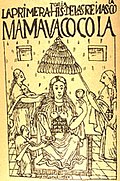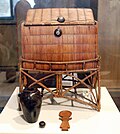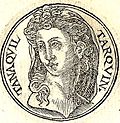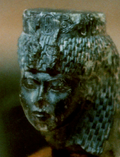List of 999 women of the Heritage Floor / Hatshepsut
This list describes the place settings for Hatshepsut on the table of Judy Chicago's art installation The Dinner Party . It is part of the list of 999 women on the Heritage Floor who are assigned to the respective place settings on the table. The names of the 999 women are on the tiles of the Heritage Floor, which is arranged below the table and belongs to the art installation.
description
The installation consists of a three-sided table, each with 13 historical or mythological personalities, thus a total of 39 people, from prehistory to the women's rights movement . These people were assigned a place setting at the table, consisting of an individually designed table runner, an individually designed plate, a goblet, knife, fork, spoon and serviette. The first page of the table is devoted to prehistory up to the Roman Empire , the second to Christianization up to the Reformation and the third from the American Revolution to the women's movement. Each place setting on the table is assigned additional personalities who have received an entry on the tiles of the Heritage Floor, which occupies the space under the table and the center of the space between the sides of the table. This list includes the personalities assigned to the Hatshepsut table setting. Your seat is on the first side of the table.
Hints
In addition to the names as they are used in German transcription or in scientific usage, the list shows the spelling chosen by Judy Chicago on the tiles.
The information on women who do not yet have an article in the German-language Wikipedia is referenced by the individual references listed under comments . If individual information in the table is not referenced via the main article, additional individual references are given at the relevant point. If there are any discrepancies between the information provided in Wikipedia articles and the descriptions of the work of art on the Brooklyn Museum website , this will also be indicated under Comments.
Place setting for Hatshepsut
Hatshepsut was an ancient Egyptian queen who was assigned to the 18th Dynasty ( New Kingdom ). She ruled from about 1479 to 1458 BC. The name Hatshepsut means "the first of the noble women". Her father was Thutmose I and her mother was Queen Ahmose . She was married to her half-brother Thutmose II , with whom she had two daughters, Meritre Hatshepsut and Neferu-Re .
After the death of Thutmose II, Hatshepsut took over the business of government for the new ruler Thutmose III. , Son of Thutmose II and his concubine Isis . Thutmose III. was around three to four years old at the time. A lot of building activity took place under the rule of Hatshepsut. She also carried out an expedition to Punt and several campaigns. In depictions she is initially shown as a woman, but later as a male with a beard, as a pharaoh.
In the art installation The Dinner Party , a relief designed place setting on the table is dedicated to Hatshepsut, as well as an inscription on the Heritage Floor as a hashop . Her table settings are meant to reflect the authority she held as the most famous female pharaoh. The design as a relief reflects the most important and popular carving method of their dynasty. The center of the plate is only slightly raised. According to Judy Chicago, this place setting is supposed to represent the transition from flat to three-dimensional plates on the dinner party table. Egyptian tomb paintings and reliefs, hairstyles, headgear, necklaces and the well-known partial profiles from Egyptian portraits were used for the design. The rule of Hatshepsut brought economic prosperity to Egypt. This is praised on the accompanying table runner. Hieroglyphs, praising the rule, were embroidered on strips of white linen, which are based on the high quality fabrics at the time of Hatshepsut's rule.
The border of the runner was designed based on the geometric pattern and the color palette of the reliefs in the mortuary temple of Hatshepsut . The back of the runner is embroidered with two blue-green semicircles, which are reminiscent of the pharaonic collars at the time of Hatshepsut. In ancient Egypt, blue-green was an important color as it was associated with the gods and rulers who wore the color visually associated with gods and goddesses. The initial letter "H" on the front of the runner combines the Egyptian symbols of the eye, justice and the life-giving symbol of the pharaoh, the Ankh .
| Surname | Spelling on the tile | Date of birth | cultural spatial assignment | Remarks | image |
|---|---|---|---|---|---|
| Chuit | Khuwyt | around 1960 BC Ch. | Old Egypt | One of the first musicians known by name. It is only known from the inscription on a mural in the burial chapel of the Senet, mother or wife of Antefiqer . It shows her as a singer and harpist. | |
| Dido | Dido | N / A | Phenicia | According to the founding legend, a Phoenician princess and the founder of Carthage . |

|
| En-nigaldi-Nanna | Bel Shalti fool | before 554 BC Ch. | Babylonia | Daughter of the Babylonian king Nabu-na'id and high priestess. | |
| Hatshepsut | Hashop | 14th century BC Chr. | New kingdom | Ancient Egyptian Queen ( Pharaoh ). It is attributed to the 18th Dynasty ( New Kingdom ). |

|
| Queen of Sheba | Makeda | N / A | Old testament |
Biblical figure dating back to the 10th century BC. Chr. A trip to the court of King Solomon in Jerusalem is said to have made. Is mentioned in the Old Testament , Koran and Ethiopian legends.
In the installation of Makeda it is stated that this is the Ethiopian name of the Queen of Sheba and that Saba would have been a kingdom that is mentioned in the Old Testament and the Koran and that it is spatially located in Yemen or Ethiopia. As a supposedly very wealthy queen, she heard of the wisdom of King Solomon and traveled to his court with many gifts to consult him. It is reported that Makeda was very impressed with Solomon's kingdom and that Solomon returned the gifts. It is unclear whether Makeda had an affair with King Solomon, but the royal family of Ethiopia attribute their ancestry to these two. |

|
| Queen of Sheba | Nicaula | N / A | Old testament |
biblical figure who lived in the 10th century BC Chr. A trip to the court of King Solomon in Jerusalem is said to have made. Is mentioned in the Old Testament , Koran and Ethiopian legends.
The information on Nicaula in the project is the same as for Makeda. |
|
| Lucretia | Lucretia | N / A | Roman royal period | Roman woman from the (semi) mythical early period, daughter of Spurius Lucretius Tricipitinus and wife of Collatinus from the royal family of the Tarquinians, killed herself after being raped. |

|
| Mama Ocllo | Mama Oclo | N / A | Inca mythology | In Inca mythology, a fertile deity and mother. Sister of the Inca ruler Manco Cápac , daughter of the sun god Inti and his wife Mama Killa . |

|
| Mentuhotep | Mentuhetop | between 1700 and 1550 BC Ch. | Second split | Wife of the Egyptian king Djehuti . |

|
| Naqia | Naqi'a | around 730 BC Chr. | Assyrian Empire | Wife of the Assyrian king Sennacherib , daughter-in-law of Sargon , mother of Azarhaddon and grandmother of Ashurbanipal . |

|
| Nitokris | Nitocris | 6th century BC Chr. | Babylonia | Queen of Babylon mentioned in the Histories of Herodotus . | |
| Nofret (II.) | Nefertiti | around 1900 BC Chr. | Middle realm | Royal lady with the title "natural king's daughter". |

|
| Nefertiti | Nefertiti | 14th century BC Chr. | New kingdom | Chief wife ( Great Royal Wife ) of Pharaoh Akhenaten (Amenhotep IV). |

|
| Phantasia | Phantasia | N / A | Old Egypt | Legend has it that Phantasia, daughter of Nicarchus, a teacher of philosophy in Memphis, Egypt, wrote an account of the Trojan War and the adventures of Odysseus. This is said to have been adopted by Homer when creating the Iliad and the Odyssey. As with Homer, it is not known whether Phantasia was a real personality. | |
| Puduḫepa | Puduchepa | 13th century BC Chr. | Hittites | Hittite great queen of the 13th century BC Chr. |

|
| Rahonem | Rahonem | around 2500 BC Chr. | Old empire | Temple priestess and musician. | |
| Semiramis | Semiramis | N / A | Old Orient | Ancient oriental heroine or queen . |

|
| Tanaquil | Tanaquil | around 600 BC Chr. | Roman royal period | Ambitious wife of Lucius Tarquinius Priscus , the fifth Roman king . She hid her husband's death until the succession to the throne was secured for Servius Tullius , her daughter Tarquinia's husband. |

|
| Teje | Tiy | 1398 BC Chr. | New kingdom | Great royal consort and de facto co-regent of the Egyptian pharaoh Amenophis III. She also played a political role under her son Akhenaten , the extent of which is unclear. |

|
| Tetisheri | Tetisheri | 16th century BC Chr. | New kingdom | Great royal consort and queen mother . She is considered the " ancestral mother of the Ahmosids ". |

|
- Individual evidence
- ↑ Brooklyn Museum: Hatshepsut. In: brooklynmuseum.org. Retrieved October 10, 2019 .
- ↑ Brooklyn Museum: Makeda. In: brooklynmuseum.org. Retrieved October 6, 2019 .
- ↑ Brooklyn Museum: Nicaula. In: brooklynmuseum.org. Retrieved October 6, 2019 .
- ^ Brooklyn Museum: Phantasia. In: brooklynmuseum.org. Retrieved October 6, 2019 .
- ↑ Brooklyn Museum: Rahonem. In: brooklynmuseum.org. Retrieved October 6, 2019 .
Web links
- Brooklyn Museum, Hatshepsut
- The Dinner Party on the website of Through the Flower , Judy Chicago's non-profit organization
